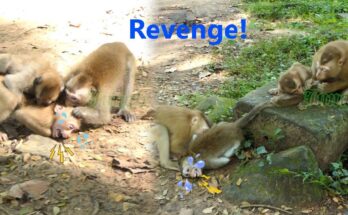
The monkeys, driven by hunger and curiosity, would sneak into the village early in the morning. They would raid fruit trees, pull up young plants from gardens, and even snatch food from kitchens left unattended. Despite the villagers’ best efforts to scare them away by shouting or banging pots, the monkeys always returned, becoming bolder with each visit. Families were beginning to worry not only about their livelihoods but also about potential bites and scratches, which could lead to injuries or diseases.
After several months of ongoing damage, the local pest control team was called in. This team specialized in wildlife management and understood that the goal was not to harm the monkeys but to deter them from causing destruction. They set up observation points to study the monkeys’ daily routines. Soon, they discovered that the troop entered the village from a particular forest path and left the same way.
Using this information, the team decided to use humane methods to redirect the monkeys away from the village. They installed non-harmful traps and used natural deterrents like chili powder along the entry routes, which monkeys dislike because of the strong smell. They also introduced noise devices that activated when motion was detected, startling the monkeys without injuring them.
The villagers worked closely with the pest control experts, learning how to secure food storage areas and cover fruit trees with protective nets. Over time, the monkeys realized that the village was no longer an easy source of food. They gradually returned deeper into the forest, where they could find natural resources without conflict.
This operation demonstrated the importance of balancing human needs with wildlife conservation. While the title “Hunting Monkey” might sound aggressive, the reality was far more thoughtful and humane. The pest control team understood that the monkeys were not pests by nature; they were simply adapting to survive in an environment where human activity had reduced their natural food sources. By using smart, non-lethal techniques, the villagers were able to protect their crops and property while ensuring the monkeys remained safe in their habitat.
Stories like these remind us that humans and wildlife must learn to coexist. Villagers gained new respect for the animals, recognizing that they were part of the ecosystem. Meanwhile, the monkeys learned to avoid human settlements, finding safety in the forest. The cooperation between pest control professionals and the community ultimately brought peace back to the area.


